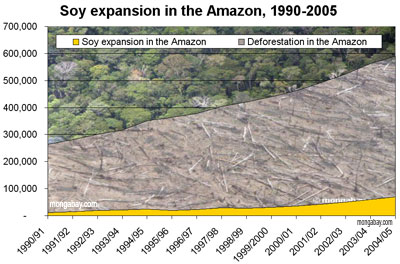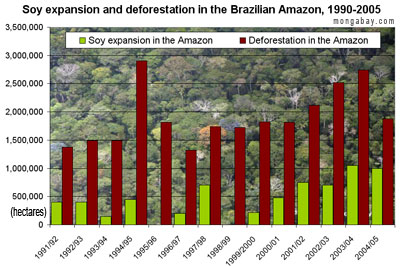China urged to join sustainable soy efforts in the Amazon
China urged to join sustainable soy efforts in the Amazon
mongabay.com
September 12, 2007
Brazilian soy crushers have urged China to join an alliance to promote sustainable soybean production in the Amazon, according to Reuters.
“Sustainability is a huge issue,” Robert Broeska, president of International Association of Seed Crushers, told Reuters at a conference in southern China. “China is such a big part of the success formula in South American soybeans. They must be involved.”
Brazil, soon to be the world’s largest producer of soybeans, recently formed the Global Roundtable on Responsible Soy Association as concerns grow that global demand for biofuels will level the Amazon rainforest. Environmentalists say demand from China is playing an important role in surging soybean production in the region.
 Soy expansion in the Brazilian Amazon, 1990-2005 Total deforestation and area of soybean cultivation across states in the Brazilian Amazon. Overall soybean cultivation makes up only a small portion of deforestation, though its role is accelerating. Further, soybean expansion and the associated infrastructure development and farmer displacement is driving deforestation by other actors. Note: some soybean farms are established on already degraded rainforest lands and neighboring cerrado ecosystems. Therefore it would be inappropriate to assume the area of soybean planting represents its actual role in deforestation.  Annual deforestation rates and annual soy expansion for states in the Brazilian Amazon 1990-2005. Note that the 1995-1996 and 1998-1999 years were negative and do not show up on the chart. Graphs based on Brazilian government data. |
According to Reuters, the Brazilian Oils and Fats Industry Association (Abiove), a member of the Brazilian Roundtable, and Brazil’s National Grain Exporters Association recently said they would not to trade soy that originates from the Amazon. Last year, after an investigation by Greenpeace linked Amazon soy to chicken feed used to supply McDonald’s and other fast-food restaurants in Europe, a consortium of Brazil’s largest soy crushers announced a two-year moratorium on trading soybeans grown on newly deforested lands in the Amazon basin. During that time the agricultural sector will work with the Brazilian government to prepare an effective mapping and monitoring system for the Amazon biome, develop strategies to encourage soy producers to comply with the Brazilian forestry laws, and work with other groups to layout rules on how to conduct operations in the region.
The industry-driven trend is a hopeful sign that sustainability is gaining traction in the Amazon. Aliança da Terra, an organization founded by a Texas rancher named John Cain Carter and his wife Kika, is working on a certification platform for Brazilian cattle ranchers — the largest drivers of deforestation in the Amazon. Carter believes that by giving producers incentives to reduce their impact on the environment, the market can succeed where conservation efforts have failed.
“We’re setting up an accrediting mechanism that will help responsible landowners gain access to markets and get the best price for their products,” Carter told mongabay.com.
As the world’s fastest growing consumer of commodities, bringing China on board would be a boon to these efforts. China has already shown some interest in sustainability, issuing a draft sustainable forestry handbook earlier this year for Chinese companies operating overseas. The guidelines call for a ban on illegal logging and clearing of natural forests for plantations.
Related
Biofuels driving destruction of Brazilian cerrado. Demand for biofuels is driving the destruction of Brazil’s cerrado, one of the planet’s most biodiverse savanna ecosystems. The cerrado, wooded grassland in Brazil that once covered an area half the size of Europe, is fast being transformed into croplands to meet rising demand for soybeans, sugarcane, and cattle. The cerrado is now disappearing more than twice as the rate as the neighboring Amazon rainforest, according to a Brazilian expert on the savanna ecosystem.
Can cattle ranchers and soy farmers save the Amazon?
John Cain Carter, a Texas rancher who moved to the the Brazilian state of Mato Grosso 11 years ago and founded what is perhaps the most innovative organization working in the Amazon, Aliança da Terra, believes the only way to save the Amazon is through the market. Carter says that by giving producers incentives to reduce their impact on the forest, the market can succeed where conservation efforts have failed. What is most remarkable about Aliança’s system is that it has the potential to be applied to any commodity anywhere in the world. That means palm oil in Borneo could be certified just as easily as sugar cane in Brazil or sheep in New Zealand. By addressing the supply chain, tracing agricultural products back to the specific fields where they were produced, the system offers perhaps the best market-based solution to combating deforestation. Combining these approaches with large-scale land conservation and scientific research offers what may be the best hope for saving the Amazon.
Globalization could save the Amazon rainforest
The Amazon basin is home to the world’s largest rainforest, an ecosystem that supports perhaps 30 percent of the world’s terrestrial species, stores vast amounts of carbon, and exerts considerable influence on global weather patterns and climate. Few would dispute that it is one of the planet’s most important landscapes. Despite its scale the Amazon is also one of the fastest changing ecosystems, largely as a result of human activities, including deforestation, forest fires, and, increasingly, climate change. Few people understand these impacts better than Dr. Daniel Nepstad, one of the world’s foremost experts on the Amazon rainforest. Now head of the Woods Hole Research Center’s Amazon program in Belém, Brazil, Nepstad has spent more than 23 years in the Amazon, studying subjects ranging from forest fires and forest management policy to sustainable development. Nepstad says the Amazon is presently at a point unlike any he’s ever seen, one where there are unparalleled risks and opportunities. While he’s hopeful about some of the trends, he knows the Amazon faces difficult and immediate challenges.
This article used information from Reuters and previous mongabay.com posts.